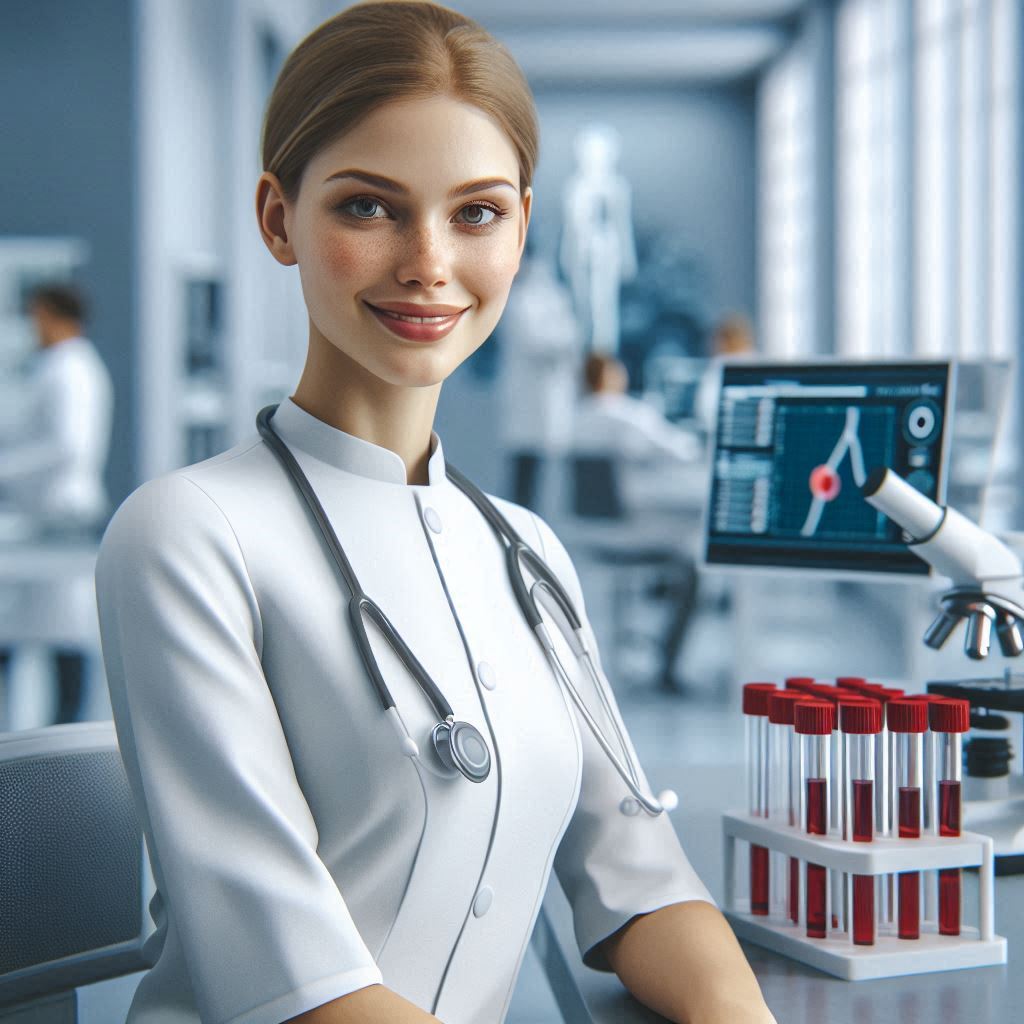Introduction
Technological Advances in Clinical Laboratory Science: In the realm of healthcare, technological advancements have profoundly reshaped the landscape of clinical laboratory science, revolutionizing the way diagnostic tests are conducted and interpreted.
This post explores the pivotal role of technology in enhancing efficiency, accuracy, and overall effectiveness within clinical laboratories.
Technology stands as a cornerstone in modern clinical laboratory science, driving improvements in efficiency and accuracy across diagnostic processes.
Automated systems streamline routine tests, reducing human error and expediting results.
For instance, automated analyzers can perform multiple tests simultaneously, processing samples with precision and speed that surpasses manual methods.
This capability not only accelerates turnaround times but also ensures consistent and reliable outcomes, crucial in urgent medical situations.
Advancements in technology have ushered in a new era for clinical laboratory science, transcending traditional practices and expanding diagnostic capabilities.
Molecular diagnostics, enabled by genomic sequencing and PCR technologies, have revolutionized disease detection and monitoring.
These techniques allow for earlier detection of genetic predispositions and infectious agents, empowering healthcare providers with insights that guide personalized treatment strategies.
Moreover, the integration of artificial intelligence (AI) has propelled diagnostic accuracy to unprecedented heights.
Machine learning algorithms analyze vast datasets to identify patterns and anomalies that human eyes might overlook.
This capacity not only enhances diagnostic precision but also supports predictive analytics, foreseeing potential health risks based on genetic, environmental, and lifestyle factors.
Automation in Laboratory Testing
In the realm of clinical laboratory science, automation stands as a pivotal advancement that has reshaped the landscape of diagnostic testing.
Historically reliant on manual processes prone to human error and variability, laboratories have increasingly turned to automation to enhance efficiency, accuracy, and overall reliability of results.
Revolutionizing Laboratory Practices
Automation in laboratory testing involves the use of sophisticated instruments and systems to perform tasks traditionally carried out by skilled technicians.
This shift has significantly minimized human intervention in routine procedures such as sample handling, testing, and result analysis.
Automated systems excel in consistency, reducing the likelihood of errors that can occur in manual processes.
Benefits of Automation
The benefits of automation are manifold.
Firstly, speed is drastically improved; tasks that once took hours or days can now be completed in a fraction of the time.
This rapid turnaround is critical in emergency situations where timely diagnoses directly impact patient outcomes.
Transform Your Career Today
Unlock a personalized career strategy that drives real results. Get tailored advice and a roadmap designed just for you.
Start NowSecondly, automation enhances accuracy by minimizing human errors, ensuring reproducible results that contribute to better clinical decision-making.
Moreover, automation often proves more cost-effective over the long term, despite initial setup costs, by reducing labor expenses and reagent wastage.
Impactful Instruments in Clinical Practice
Examples of automated laboratory instruments abound across various disciplines.
In hematology, automated analyzers swiftly count blood cells and evaluate cell morphology with precision beyond manual microscopy.
In microbiology, automated systems identify pathogens and test their susceptibility to antibiotics, streamlining infectious disease management.
Molecular diagnostics benefit from automated PCR machines that detect genetic material with unparalleled sensitivity and specificity, pivotal in diagnosing genetic disorders and infectious diseases alike.
Automation in laboratory testing represents a paradigm shift in clinical practice, where technological advances continually refine the quality and efficiency of healthcare delivery.
By embracing automation, laboratories empower healthcare professionals with reliable, swift, and cost-effective diagnostic tools, ultimately translating into improved patient care and outcomes.
As technology evolves, so too will the capabilities of automated systems, promising a future where precision medicine becomes increasingly personalized and accessible to all.
Read: Pediatric Chiropractic Care: Is It Safe for Children?
Integration of artificial intelligence
In recent years, artificial intelligence (AI) has emerged as a transformative technology in various fields, including clinical laboratory science.
In this section, we will explore the role of AI in laboratory settings and how it is revolutionizing the way healthcare professionals analyze data and make diagnoses.
AI’s role in clinical laboratory science
- AI algorithms can analyze complex data sets quickly and efficiently, leading to improved diagnostic accuracy.
- By processing massive amounts of data in real-time, AI systems can assist healthcare professionals in making more informed decisions.
- AI technologies have the potential to greatly enhance the speed and accuracy of laboratory testing, ultimately improving patient outcomes.
AI applications in laboratory testing
- Image analysis: AI-powered algorithms can interpret medical images, such as X-rays and MRIs, to aid in the detection of abnormalities.
- Predictive analytics: AI systems can predict disease progression and treatment outcomes based on patient data, helping healthcare providers tailor treatment plans accordingly.
- Quality control: AI tools can monitor laboratory equipment performance and ensure adherence to regulatory standards, enhancing overall operational efficiency.
Overall, the integration of artificial intelligence in clinical laboratory science holds immense potential to revolutionize the way diagnoses are made and treatments are personalized.
As AI technologies continue to advance, we can expect even greater improvements in patient care and outcomes.
Read: The Connection Between Chiropractic Care and Immunity
Point-of-care testing devices
Point-of-care testing refers to medical diagnostic testing conducted near the patient, outside of the conventional laboratory setting.
These tests are essential in healthcare settings as they provide immediate results, allowing healthcare providers to make quick decisions regarding patient care.
Advancements in technology have revolutionized the field of point-of-care testing by enabling the development of portable and rapid testing devices.
These devices are compact, easy to use, and deliver results in a matter of minutes, eliminating the need for lengthy laboratory processes.
Examples of point-of-care testing devices
- Glucometers: These devices are used to measure blood glucose levels, making them invaluable for diabetes management. Patients can monitor their blood sugar levels at home, reducing the need for frequent clinic visits.
- Pregnancy test kits: These kits detect the presence of human chorionic gonadotropin (hCG) in urine, providing women with a quick and convenient way to confirm pregnancy at home.
- Rapid strep tests: These tests can quickly diagnose strep throat, allowing healthcare providers to prescribe appropriate antibiotics promptly, reducing the risk of complications.
- Influenza rapid tests: These tests detect the presence of influenza viruses in respiratory samples, helping healthcare providers identify and treat influenza infections promptly, especially during flu seasons.
Overall, point-of-care testing devices have had a significant impact on patient care and treatment.
Transform Your Career Today
Unlock a personalized career strategy that drives real results. Get tailored advice and a roadmap designed just for you.
Start NowThey have improved access to rapid diagnostics, reduced turnaround times for test results, and enhanced patient satisfaction by providing immediate feedback.
Additionally, these devices have empowered patients to take control of their health by enabling them to monitor certain conditions at home.
Read: Interview Tips for Aspiring Clinical Lab Technologists

Molecular diagnostics technologies
In the realm of clinical laboratory science, the advent of molecular diagnostics technologies has sparked a transformative wave, revolutionizing the detection and diagnosis of genetic disorders and infectious diseases.
These advancements have not only enhanced accuracy and efficiency but have also paved the way for personalized medicine tailored to individual genetic profiles.
Enhanced Detection and Diagnosis
Molecular diagnostics technologies, such as Polymerase Chain Reaction (PCR), DNA sequencing, and Next-Generation Sequencing (NGS), have significantly improved the ability to detect and diagnose both genetic disorders and infectious diseases.
PCR, for instance, amplifies small amounts of DNA to detect specific sequences, making it invaluable in identifying pathogens like viruses and bacteria with high precision and speed.
DNA sequencing techniques delve deeper, providing comprehensive genetic information that aids in diagnosing genetic disorders, predicting disease risks, and even guiding targeted therapies.
Techniques Driving Innovation
PCR remains a cornerstone in molecular diagnostics, allowing for rapid identification of genetic material in clinical samples.
Meanwhile, DNA sequencing technologies have evolved from the Sanger method to NGS, enabling simultaneous analysis of millions of DNA strands.
NGS, particularly, has expanded diagnostic capabilities by uncovering rare genetic mutations and offering insights into disease mechanisms.
Personalized Medicine Potential
The true promise of molecular diagnostics lies in its potential for personalized medicine.
By analyzing an individual’s genetic makeup, clinicians can prescribe treatments tailored to genetic predispositions, ensuring efficacy and minimizing adverse effects.
For example, pharmacogenomics uses genetic information to optimize drug selection and dosage, enhancing treatment outcomes.
Molecular diagnostics technologies represent a paradigm shift in clinical laboratory science, empowering healthcare professionals with unprecedented insights into genetic and infectious diseases.
As these technologies continue to evolve, they hold immense promise for advancing personalized medicine, where treatments are precisely calibrated to individual genetic profiles.
The future of clinical diagnostics is indeed bright, driven by innovation and the relentless pursuit of improving patient outcomes through cutting-edge molecular technologies.
Read: Chiropractic Techniques for Enhancing Athletic Performance
Telemedicine and remote monitoring
With the advancement of technology in clinical laboratory science, telemedicine and remote monitoring have revolutionized the way patients access laboratory testing.
These technologies have broken barriers to healthcare services, particularly for individuals in rural or underserved areas.
Transform Your Career Today
Unlock a personalized career strategy that drives real results. Get tailored advice and a roadmap designed just for you.
Start NowBenefits of Telemedicine and Remote Monitoring
- Increased access to laboratory testing: Patients can now receive testing without the need to travel long distances to a physical lab.
- Convenience and efficiency: Remote testing allows patients to get results quickly and conveniently, saving time and resources.
- Improved patient outcomes: Timely access to test results enables healthcare providers to make informed decisions for better patient care.
- Cost-effective: Remote testing eliminates the need for in-person visits, reducing overall healthcare expenses for patients.
Potential Challenges and Limitations
- Technology limitations: Not all patients may have access to the necessary technology for remote testing, leading to disparities in healthcare.
- Security and privacy concerns: Transmitting sensitive medical information electronically raises concerns about data privacy and security breaches.
- Lack of physical examination: Remote testing may not capture all aspects of a patient’s condition that could be assessed during an in-person visit.
- Regulatory issues: Compliance with healthcare regulations and accreditation standards may pose challenges for telemedicine providers.
In a nutshell, telemedicine and remote monitoring technologies offer significant benefits in expanding access to laboratory testing for patients in remote areas.
However, healthcare providers must be cognizant of the potential challenges and limitations associated with these technologies to ensure quality care delivery.
Delve into the Subject: Benefits of Being a Medical Transcriptionist
Data management and interoperability
- Effective data management systems are crucial for the success of laboratory testing. They ensure accuracy, reliability, and efficiency in processing test results.
- Interoperable systems allow seamless communication and collaboration among healthcare providers, laboratories, and other medical facilities.
- By integrating different systems, healthcare settings can streamline workflows, reduce errors, and improve patient care outcomes.
Importance of data management systems in laboratory testing
- Data management systems help in organizing, storing, and analyzing large volumes of patient information and test results.
- They ensure data accuracy, reduce the risk of errors, and facilitate data sharing among healthcare providers for better care coordination.
- Automation of processes through data management systems also helps in saving time, reducing manual errors, and improving overall efficiency.
Exploring how interoperable systems enhance communication and collaboration
- Interoperable systems enable seamless exchange of data between different healthcare settings, improving care coordination and patient outcomes.
- Healthcare providers can access real-time patient information, test results, and treatment plans, leading to better-informed decision-making.
- Collaboration among healthcare teams is enhanced through interoperable systems, allowing for shared best practices, treatment protocols, and improved patient care.
Significance of secure data sharing in improving patient outcomes and healthcare delivery
- Secure data sharing ensures that patient information is protected and only accessible to authorized healthcare providers, safeguarding patient privacy.
- Healthcare providers can make well-informed decisions based on real-time data, leading to personalized treatment plans and improved patient outcomes.
- Efficient data sharing also reduces duplication of tests, medical errors, and unnecessary costs, ultimately improving the quality of healthcare delivery.
Uncover the Details: Educational Path to Becoming a Substance Abuse Counselor
Conclusion
Technological advances in clinical laboratory science have revolutionized healthcare practices.
These advancements have significantly improved the accuracy, efficiency, and speed of laboratory testing processes.
The use of cutting-edge technologies like automation, robotics, artificial intelligence, and machine learning has transformed how laboratory tests are conducted.
These technologies have led to faster results, reduced human error, and increased the overall quality of patient care.
It is crucial for healthcare professionals to stay informed about the latest advancements in the field of clinical laboratory science.
By keeping up-to-date with technology, they can enhance patient care and outcomes.
Continuous learning and adaptation to new technologies are essential for providing the best possible healthcare services to patients.
In the end, the transformative impact of technology on laboratory testing practices cannot be overstated.
Embracing innovation and staying ahead of technological advancements will ultimately benefit both healthcare providers and patients.
Let’s continue to explore and adopt new technologies to improve the quality of healthcare delivery and ultimately enhance patient outcomes.




